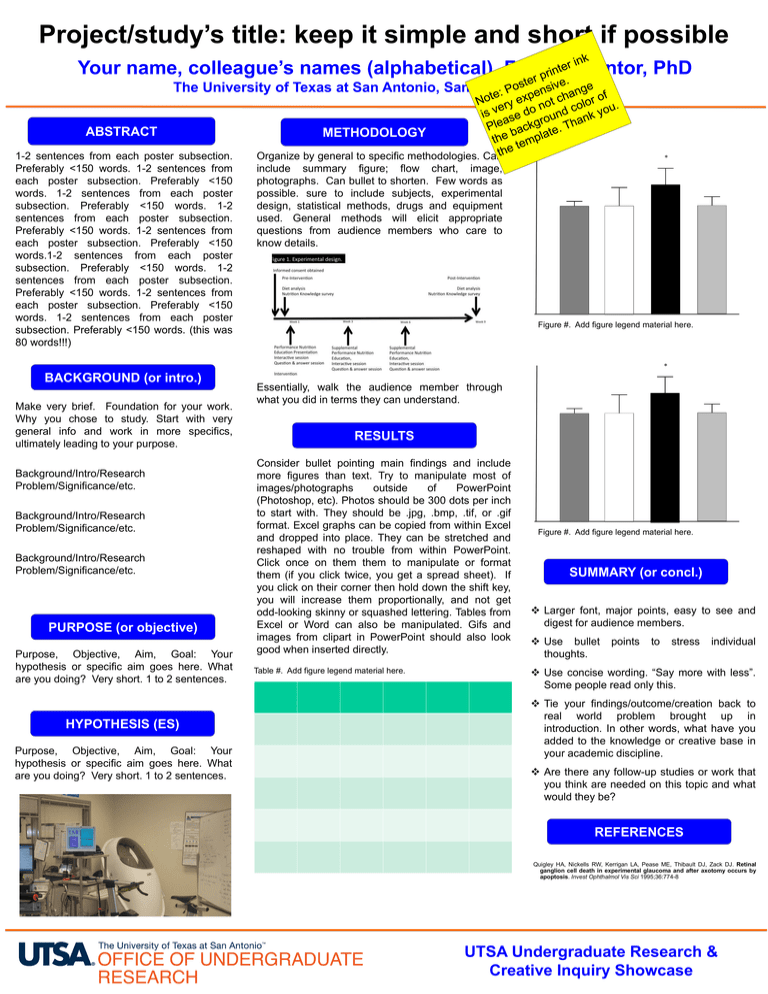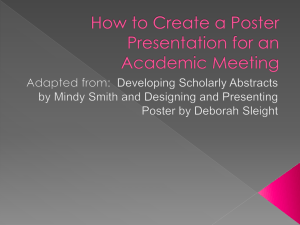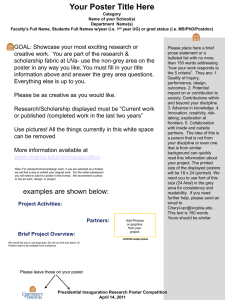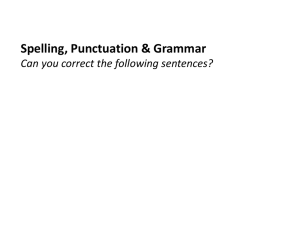Your name, colleague`s names (alphabetical
advertisement

Project/study’s title: keep it simple and short if possible Your name, colleague’s names (alphabetical), Faculty Mentor, PhD The University of Texas at San Antonio, San Antonio, TX 78249 ABSTRACT 1-2 sentences from each poster subsection. Preferably <150 words. 1-2 sentences from each poster subsection. Preferably <150 words. 1-2 sentences from each poster subsection. Preferably <150 words. 1-2 sentences from each poster subsection. Preferably <150 words. 1-2 sentences from each poster subsection. Preferably <150 words.1-2 sentences from each poster subsection. Preferably <150 words. 1-2 sentences from each poster subsection. Preferably <150 words. 1-2 sentences from each poster subsection. Preferably <150 words. 1-2 sentences from each poster subsection. Preferably <150 words. (this was 80 words!!!) METHODOLOGY Organize by general to specific methodologies. Can include summary figure; flow chart, image, photographs. Can bullet to shorten. Few words as possible. sure to include subjects, experimental design, statistical methods, drugs and equipment used. General methods will elicit appropriate questions from audience members who care to know details. * Figure #. Add figure legend material here. * BACKGROUND (or intro.) Make very brief. Foundation for your work. Why you chose to study. Start with very general info and work in more specifics, ultimately leading to your purpose. Background/Intro/Research Problem/Significance/etc. Background/Intro/Research Problem/Significance/etc. Background/Intro/Research Problem/Significance/etc. PURPOSE (or objective) Purpose, Objective, Aim, Goal: Your hypothesis or specific aim goes here. What are you doing? Very short. 1 to 2 sentences. HYPOTHESIS (ES) Purpose, Objective, Aim, Goal: Your hypothesis or specific aim goes here. What are you doing? Very short. 1 to 2 sentences. Essentially, walk the audience member through what you did in terms they can understand. RESULTS Consider bullet pointing main findings and include more figures than text. Try to manipulate most of images/photographs outside of PowerPoint (Photoshop, etc). Photos should be 300 dots per inch to start with. They should be .jpg, .bmp, .tif, or .gif format. Excel graphs can be copied from within Excel and dropped into place. They can be stretched and reshaped with no trouble from within PowerPoint. Click once on them them to manipulate or format them (if you click twice, you get a spread sheet). If you click on their corner then hold down the shift key, you will increase them proportionally, and not get odd-looking skinny or squashed lettering. Tables from Excel or Word can also be manipulated. Gifs and images from clipart in PowerPoint should also look good when inserted directly. Table #. Add figure legend material here. Figure #. Add figure legend material here. SUMMARY (or concl.) Larger font, major points, easy to see and digest for audience members. Use bullet thoughts. points to stress individual Use concise wording. “Say more with less”. Some people read only this. Tie your findings/outcome/creation back to real world problem brought up in introduction. In other words, what have you added to the knowledge or creative base in your academic discipline. Are there any follow-up studies or work that you think are needed on this topic and what would they be? REFERENCES Quigley HA, Nickells RW, Kerrigan LA, Pease ME, Thibault DJ, Zack DJ. Retinal ganglion cell death in experimental glaucoma and after axotomy occurs by apoptosis. Invest Ophthalmol Vis Sci 1995;36:774-8 UTSA Undergraduate Research & Creative Inquiry Showcase







